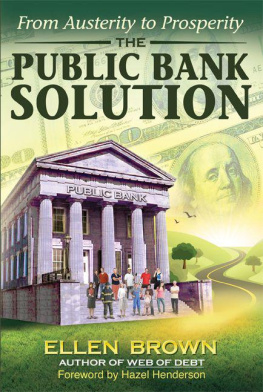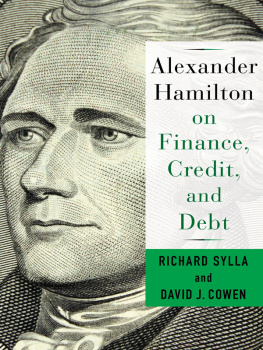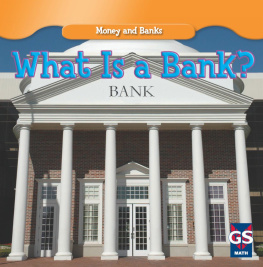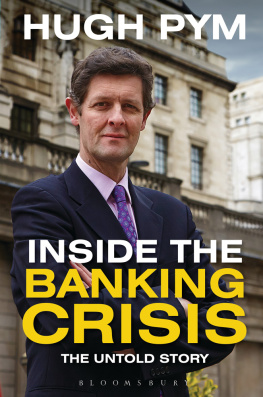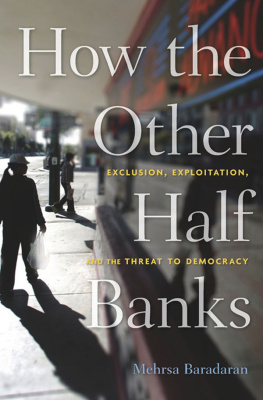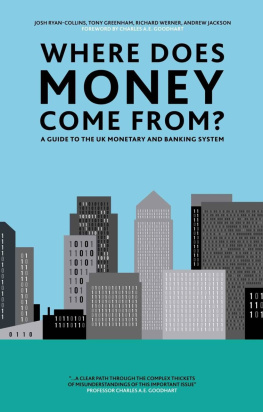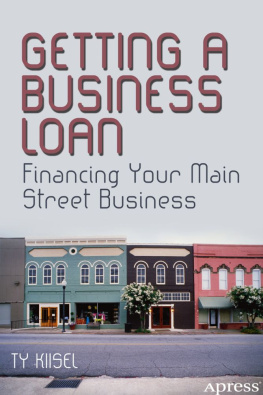The Public Bank Solution
From Austerity to Prosperity
Ellen Hodgson Brown, J.D.
Third Millennium Press
Baton Rouge, Louisiana

Copyright 2013 by Ellen Hodgson Brown
All rights reserved. No part of this book may be reproduced or transmitted in any form or by means, electronic, mechanical, photocopying, recording, or otherwise without the prior written permission of the publisher.
First edition June 2013
Cover art by David Dees, www.deesillustration.com.
Library of Congress Control Number 2013908909 Includes glossary and index.Subject headings:Banks and bankinghistory Economic history Finance, public International finance
Published by Third Millennium Press Baton Rouge, Louisiana www.webofdebt.com 800-891-0390
Printed in the United States of America
ISBN 978-0-9833308-6-8 (PRINT)
Table of Contents
Section I.
BANKING FROM WALL STREET TO BEIJING: WHY WE NEED SOMETHING NEW
Section II.
PUBLIC BANKING THROUGH HISTORY: 3,000 B.C. to 1913 A.D.
Section III.
PUBLIC BANKING MODELS SPAWNED by DEPRESSION and WAR
Section IV.
PUBLIC BANKING MODELS, HYBRIDS AND RIVALS AFTER WORLD WAR II
Section V.
SOLUTIONS: BANKING AS A PUBLIC UTILITY
To Toni Decker and Steve Hudson,
two terrific editors;
and to the dedicated public banking team
that drives this work forward
Authors Preface
This book is a sequel to Web of Debt: The Shocking Truth About Our Money System and How We Can Break Free , first published in 2007 and now in its fifth edition. After that, Lehman Brothers collapsed and took much of the global economy with it; debt and unemployment have soared; local and national governments are on the verge of bankruptcy; public services have been slashed and public assets sold off; and the derivatives casino has shot up to the sort of notional values we used to consider imaginary (quadrillion was an imaginary number when I was a child). In the latest affront, banks in Cyprus were instructed to confiscate the funds of their depositors, and weve learned that banks globally that are considered systemically important and systemically risky are being instructed to follow suit if necessary to keep their doors open. All this has brought renewed attention to the banking crisis, and a sense of urgency in finding solutions.
Web of Debt looked at how the power to create money has been usurped by a private banking oligarchy, and how it can be restored to the people at the federal level. This book expands the focus to more local, grassroots alternatives for getting back the money power, by owning some banks ourselves. To that end, it explores the considerable proven successes of the public banking model historically and in the contemporary world.
Writing a book is a bit like sculpture. You begin with a mass of raw material, and each time you go over it, the form within emerges with greater clarity. I have been working with this mass of material for over five years, yet the form and meaning of it are still emerging, so that I am reluctant to let go of it; but the crush of events propels me to speed to press.
My focus has been on what is new and interestingmaterial that helps fill in the gaps, see connections, or appreciate the other side of the stories we heard in school or have gotten filtered through the media. It is hard to know what is really happening on the other side of the world, concealed in economic data in other languages. My approach has been to let the sources speak for themselves, with heavy reliance on quotes and citations, so that readers can form their own opinions and carry on with their own research. There are many stories yet to be told and gaps to be filled.
For ease of reading, each chapter has been summarized in a block at the beginning. The italicized emphases in quotes are mine. Material from Web of Debt has been reviewed and expanded on concerning the tally system, the Bank of England, and the early American banking system, both to bring new readers up to speed and to lay the groundwork for the new material that follows. My own thinking has evolved concerning this history, which has taken on new relevance in the public bank context.
I hope you will find this book as engaging to read as I have found it to research and write.
Ellen Brown
Newhall, California
June 2013
Foreword By Hazel Henderson
It is a special privilege to write the Foreword to this important new book. Lawyer Ellen H. Brown has a well-earned reputation for meticulous research and investigative reporting in her many books. In this groundbreaking volume, she emerges as a key public intellectual resource in understanding the politics of money-creation, credit allocation and how democracies can and must regain control over todays global casino. The Public Bank Solution is the most comprehensive overview of how the global financial system has now evolved into a predatory interlocking apparatus which extracts real wealth from productive activities and local economies while exploiting the ecological life-supporting planetary ecosystem on which humanity and all species rely. Ellen is repeatedly called on for her expertise because she offers so many creative proposals for reform along with her in-depth analyses of our current malfunctioning money-creation and credit-allocation policies.
Ellen founded and is president of the Public Banking Institute (PBI), and I am honored to serve on its Advisory Board. PBI champions and fosters the needed return in the USA of public banking. This book focuses our attention on public banking after the Wall Street debacles of 2008 and shows how deeper reforms than Dodd-Frank are needed. Too-big-to-fail banks, now bigger than ever, continue to devastate the lives of millions in our real economy. Ellen led in drawing attention to the over 90 years of success of the publicly owned Bank of North Dakota, focused the wave of media attention on this better model and shows how other public banks around the world lead to better, more equitable forms of economic and social development.
In this book, Ellen gives us a detailed history of the success of public banks in many countries and how they serve the democratic development of robust economies, plowing their revenues back into further community credit needs: for infrastructure, education, health facilities, local enterprises, and providing funds to many other local community banks. The success of these public banks throughout history and today puts them in the crosshairs of the armies of lobbyists for the big for-profit banks. This book documents some of these David and Goliath battles and todays new opportunities to re-launch public banks in the wake of the Wall Street depredations and the scandalous taxpayer funded-bailouts. The bailouts were extorted from meek or terrified politicians, many compromised by Wall Streets campaign donations, who fell into line and still serve these financial interests today. The appalling 2010 Supreme Court Citizens United decision has turned U.S. elections into a farce in which Congress and the Executive Branch are on the auction block to the highest bidder. There are many efforts to overturn this Supreme Court mistake, such as a Constitutional amendment to clarify that money is not speech and corporations are not persons. Meanwhile, we can act to restore our own communities and keep our money circulating locally and domestically.
This book is a boon to all communities and activists seeking to re-start and support their homegrown economies. While the mystification is purveyed by elites and mass media that the USA is still suffering a Great Recession, Ellen Browns research finds root causes and deeper explanations. Ellen explains the working of fractional reserve banking and how the power to create our countrys money fell into private hands under the Federal Reserve Act of 1913, allowing the private owners of its 12 Federal Reserve banks and our entire banking system to create our money supply out of thin air, simply as loans which are then credited to the borrowers account. Some 95 percent of our money supply is created through these bank loans and the huge bubble of securitized mortgages, student loans, car loans, etc., which are packaged up as bonds and sold to unsuspecting pension funds. When these bonds turned out to be full of toxic sub-prime loans, credit markets dried up, lending collapsed, and our money supply collapsed with it! This collapse of our domestic money supply still strangles the economies of Main Street, drying up the circulating cash needed for businesses, payrolls, and mortgage payments, causing the tragedies we have witnessed of unemployment, foreclosures and rising U.S. poverty rates.

